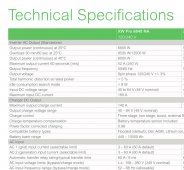Hedges
I See Electromagnetic Fields!
- Joined
- Mar 28, 2020
- Messages
- 21,530
One key decision is batteries.
LiFePO4 and server-rack batteries are popular and have a number of advantages, but there are still teething pains. A key advantage, high charge rate, is only useful for a small battery (e.g. sized for 1 or 2 hours PV production and usage.)
I would assume FLA forklift batteries are readily available in PR. Maybe $6k for 40 kWh, and could last 20 years if sized for 3 days without sun.
I use AGM, twice the price and half the lifespan of forklift batteries. $6k for 20 kWh. I selected them for zero maintenance and high surge current, sized for a bit over 1 hour's PV production but I charge at 0.2C
To go cheap, could use golf cart batteries initially. Maybe $1k for 10 kWh? After some experience and a maturing of the lithium battery market you can decide what to use next.
If you avoid drawing from the battery, e.g. run A/C only while the sun shines, you may get by with a smaller and less expensive battery. Mine for instance is sized to last one 12 hour night, powering a bunch of inefficient refrigerators/freezers. An appliance replacement, or switching them off at night, and my battery could have been half the size.
LiFePO4 and server-rack batteries are popular and have a number of advantages, but there are still teething pains. A key advantage, high charge rate, is only useful for a small battery (e.g. sized for 1 or 2 hours PV production and usage.)
I would assume FLA forklift batteries are readily available in PR. Maybe $6k for 40 kWh, and could last 20 years if sized for 3 days without sun.
I use AGM, twice the price and half the lifespan of forklift batteries. $6k for 20 kWh. I selected them for zero maintenance and high surge current, sized for a bit over 1 hour's PV production but I charge at 0.2C
To go cheap, could use golf cart batteries initially. Maybe $1k for 10 kWh? After some experience and a maturing of the lithium battery market you can decide what to use next.
If you avoid drawing from the battery, e.g. run A/C only while the sun shines, you may get by with a smaller and less expensive battery. Mine for instance is sized to last one 12 hour night, powering a bunch of inefficient refrigerators/freezers. An appliance replacement, or switching them off at night, and my battery could have been half the size.








